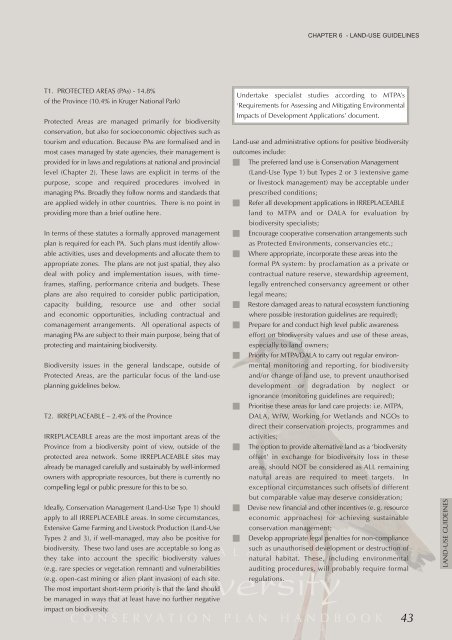Mpumalanga Biodiversity Conservation Plan Handbook - bgis-sanbi
Mpumalanga Biodiversity Conservation Plan Handbook - bgis-sanbi
Mpumalanga Biodiversity Conservation Plan Handbook - bgis-sanbi
You also want an ePaper? Increase the reach of your titles
YUMPU automatically turns print PDFs into web optimized ePapers that Google loves.
T1. PROTECTED AREAS (PAs) - 14.8%<br />
of the Province (10.4% in Kruger National Park)<br />
Protected Areas are managed primarily for biodiversity<br />
conservation, but also for socioeconomic objectives such as<br />
tourism and education. Because PAs are formalised and in<br />
most cases managed by state agencies, their management is<br />
provided for in laws and regulations at national and provincial<br />
level (Chapter 2). These laws are explicit in terms of the<br />
purpose, scope and required procedures involved in<br />
managing PAs. Broadly they follow norms and standards that<br />
are applied widely in other countries. There is no point in<br />
providing more than a brief outline here.<br />
In terms of these statutes a formally approved management<br />
plan is required for each PA. Such plans must identify allowable<br />
activities, uses and developments and allocate them to<br />
appropriate zones. The plans are not just spatial, they also<br />
deal with policy and implementation issues, with timeframes,<br />
staffing, performance criteria and budgets. These<br />
plans are also required to consider public participation,<br />
capacity building, resource use and other social<br />
and economic opportunities, including contractual and<br />
comanagement arrangements. All operational aspects of<br />
managing PAs are subject to their main purpose, being that of<br />
protecting and maintaining biodiversity.<br />
<strong>Biodiversity</strong> issues in the general landscape, outside of<br />
Protected Areas, are the particular focus of the land-use<br />
planning guidelines below.<br />
T2. IRREPLACEABLE – 2.4% of the Province<br />
IRREPLACEABLE areas are the most important areas of the<br />
Province from a biodiversity point of view, outside of the<br />
protected area network. Some IRREPLACEABLE sites may<br />
already be managed carefully and sustainably by well-informed<br />
owners with appropriate resources, but there is currently no<br />
compelling legal or public pressure for this to be so.<br />
Ideally, <strong>Conservation</strong> Management (Land-Use Type 1) should<br />
apply to all IRREPLACEABLE areas. In some circumstances,<br />
Extensive Game Farming and Livestock Production (Land-Use<br />
Types 2 and 3), if well-managed, may also be positive for<br />
M P U M A L A N G A<br />
biodiversity. These two land uses are acceptable so long as<br />
<strong>Biodiversity</strong><br />
they take into account the specific biodiversity values<br />
(e.g. rare species or vegetation remnant) and vulnerabilities<br />
(e.g. open-cast mining or alien plant invasion) of each site.<br />
The most important short-term priority is that the land should<br />
be managed in ways that at least have no further negative<br />
impact on biodiversity.<br />
CHAPTER 6 - LAND-USE GUIDELINES<br />
Undertake specialist studies according to MTPA’s<br />
‘Requirements for Assessing and Mitigating Environmental<br />
Impacts of Development Applications’ document.<br />
Land-use and administrative options for positive biodiversity<br />
outcomes include:<br />
The preferred land use is <strong>Conservation</strong> Management<br />
(Land-Use Type 1) but Types 2 or 3 (extensive game<br />
or livestock management) may be acceptable under<br />
prescribed conditions;<br />
Refer all development applications in IRREPLACEABLE<br />
land to MTPA and or DALA for evaluation by<br />
biodiversity specialists;<br />
Encourage cooperative conservation arrangements such<br />
as Protected Environments, conservancies etc.;<br />
Where appropriate, incorporate these areas into the<br />
formal PA system: by proclamation as a private or<br />
contractual nature reserve, stewardship agreement,<br />
legally entrenched conservancy agreement or other<br />
legal means;<br />
Restore damaged areas to natural ecosystem functioning<br />
where possible (restoration guidelines are required);<br />
Prepare for and conduct high level public awareness<br />
effort on biodiversity values and use of these areas,<br />
especially to land owners;<br />
Priority for MTPA/DALA to carry out regular environ-<br />
mental monitoring and reporting, for biodiversity<br />
and/or change of land use, to prevent unauthorised<br />
development or degradation by neglect or<br />
ignorance (monitoring guidelines are required);<br />
Prioritise these areas for land care projects: i.e. MTPA,<br />
DALA, WfW, Working for Wetlands and NGOs to<br />
direct their conservation projects, programmes and<br />
activities;<br />
The option to provide alternative land as a ‘biodiversity<br />
offset’ in exchange for biodiversity loss in these<br />
areas, should NOT be considered as ALL remaining<br />
natural areas are required to meet targets. In<br />
exceptional circumstances such offsets of different<br />
but comparable value may deserve consideration;<br />
Devise new financial and other incentives (e. g. resource<br />
economic approaches) for achieving sustainable<br />
conservation management;<br />
Develop appropriate legal penalties for non-compliance<br />
such as unauthorised development or destruction of<br />
natural habitat. These, including environmental<br />
auditing procedures, will probably require formal<br />
regulations.<br />
CONSERVATION PLAN HANDBOOK<br />
43<br />
LAND-USE GUIDEINES

















